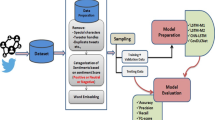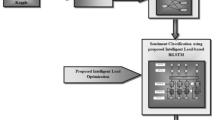Abstract
With the Internet's rapid development and the increasing amount of netizens, social contradictions frequently manifest over the Internet. Public emergencies develop and spread constantly online. Thus, it is of great significance to reasonably address the Online Public Sentiment (OPS) in the current critical stage of social transformation. The aim is to create a safe and credible network environment and realize the modern transformation of the dynamic evolution of OPS in public emergencies. Firstly, this paper expounds on the blocking process of the OPS evolution on public emergencies according to the Internet of Things-native big data. Then, it discusses the algorithm process of the Long Short-Term Memory (LSTM) Neural Network (NN) model. Further, it optimizes the LSTM NN model using the Adaptive Momentum Estimation (Adam). Finally, it simulates and predicts the OPS evolution using Artificial Intelligence technology and big data. The results show that the Adam-optimized LSTM NN model can predict the hotness of OPS in the dynamic evolution with high prediction accuracy. In predicting OPS evolution, the Mean Relative Errors (MRE) of the proposed Adam-LSTM, LSTM, and Backpropagation NN models are 0.06, 0.10, and 0.14, respectively. The proposed Adam-LSTM model presents the least MRE on the hotness of OPS. The relevant governments can refer to model-predicted OPS evolution to control public emergencies and OPS through the IoT. Therefore, the proposed Adam-LSTM model is feasible for predicting the OPS hotness. The finding has particular research significance for employing the LSTM model under the IoT in predicting the OPS evolution in public emergencies. Lastly, the OPS on public emergencies can be effectively guided thanks to the proposed Adam-LSTM prediction model and time nodes.








Similar content being viewed by others
Data availability statement
The raw data supporting the conclusions of this article will be made available by the authors, without undue reservation.
References
Cui H, Kertész J (2022) Born in Rome or Sleeping Beauty: Emergence of hashtag popularity on a microblogging site. arXiv preprint arXiv, 2203(1):14802. https://doi.org/10.48550/arXiv.2203.14802
Miravet-Verde S, Burgos R, Delgado J et al (2020) FASTQINS and ANUBIS: two bioinformatic tools to explore facts and artifacts in transposon sequencing and essentiality studies. Nucleic Acids Res 48(17):e102–e102. https://doi.org/10.1093/nar/gkaa679
Song S, Guo Z, Wang X et al (2021) RETRACTED ARTICLE: The correlation between social transformation economic risk and Internet public opinion. Behav Inf Technol 40(7):723–733. https://doi.org/10.1080/0144929X.2020.1722750
Larrouquere L, Gabin M, Poingt E et al (2020) Genesis of an emergency public drug information website by the French Society of Pharmacology and Therapeutics during the COVID-19 pandemic. Fundam Clin Pharmacol 34(3):389–396. https://doi.org/10.1111/fcp.12564
Muniz-Rodriguez K, Ofori SK, Bayliss LC et al (2020) Social media use in emergency response to natural disasters: a systematic review with a public health perspective. Disaster Med Public Health Prep 14(1):139–149. https://doi.org/10.1017/dmp.2020.3
Merkley E, Bridgman A, Loewen PJ et al (2020) A rare moment of cross-partisan consensus: Elite and public response to the COVID-19 pandemic in Canada. Can J Polit Sci/Revue Canadienne de science politique 53(2):311–318. https://doi.org/10.1017/S0008423920000311
Boon-Itt S, Skunkan Y (2020) Public perception of the COVID-19 pandemic on Twitter: sentiment analysis and topic modeling study. JMIR Public Health Surveillance, 6(4):e21978. https://doi.org/10.2196/21978
Zhang W, Wang Y, Yang L et al. (2020) Suspending classes without stopping learning: China's education emergency management policy in the COVID-19 outbreak. J Risk Financ Manage 13(3):55. https://doi.org/10.3390/jrfm13030055
Wang B, Wang E, Zhu Z et al. (2021) An explainable sentiment prediction model based on the portraits of users sharing representative opinions in social sensors. Int J Distrib Sens Netw 17(10):15501477211033765. https://doi.org/10.1177/15501477211033765
Shen L, Yao R, Zhang W et al (2021) Emotional attitudes of Chinese citizens on social distancing during the COVID-19 outbreak: analysis of social media data. JMIR Med Inf 9(3):e27079. https://doi.org/10.2196/27079
Xiao Y, Li J, Zhu Y et al (2020) User Behavior prediction of social hotspots based on multimessage interaction and neural network. IEEE Trans Comput Soc Syst 7(2):536–545. https://doi.org/10.1109/TCSS.2020.2969484
Tavoschi L, Quattrone F, D’Andrea E et al (2020) Twitter as a sentinel tool to monitor public opinion on vaccination: an opinion mining analysis from September 2016 to August 2017 in Italy. Hum Vaccin Immunother 16(5):1062–1069. https://doi.org/10.1080/21645515.2020.1714311
Yadav A, Vishwakarma DK (2020) Sentiment analysis using deep learning architectures: a review. Artif Intell Rev 53(6):4335–4385. https://doi.org/10.1007/s13042-018-0799-4
Jain PK, Yekun EA, Pamula R et al (2021) Consumer recommendation prediction in online reviews using Cuckoo optimized machine learning models. Comput Electr Eng 95(1):107397. https://doi.org/10.1016/j.compeleceng.2021.107397
Munawar H S, Qayyum S, Ullah F et al. (2020) Big data and its applications in smart real estate and the disaster management life cycle: a systematic analysis. Big Data Cognit Comput 4(2:4. https://doi.org/10.3390/bdcc4020004
Murphy J, Link MW, Childs JH et al (2014) Social media in public opinion research: Executive summary of the AAPOR task force on emerging technologies in public opinion research. Public Opin Q 78(4):788–794. https://doi.org/10.1093/poq/nfu053
Han X, Wang J, Zhang M et al (2020) Using social media to mine and analyze public opinion related to COVID-19 in China. Int J Environ Res Public Health 17(8):2788. https://doi.org/10.3390/ijerph17082788
Ding G, Qin L (2020) Study on the prediction of stock price based on the associated network model of LSTM. Int J Mach Learn Cybern 11(6):1307–1317. https://doi.org/10.1007/s13042-019-01041-1
Zheng H, Lin F, Feng X et al (2020) A hybrid deep learning model with attention-based conv-LSTM networks for short-term traffic flow prediction. IEEE Trans Intell Transp Syst 22(11):6910–6920. https://doi.org/10.1109/TITS.2020.2997352
Lu W, Rui H, Liang C et al (2020) A method based on ga-cnn-lstm for daily tourist flow prediction at scenic spots. Entropy 22(3):261. https://doi.org/10.3390/e22030261
Ma D, Song X, Li P (2020) Daily traffic flow forecasting through a contextual convolutional recurrent neural network modeling inter-and intra-day traffic patterns. IEEE Trans Intell Transp Syst 22(5):2627–2636. https://doi.org/10.1109/TITS.2020.2973279
Kumar A, Islam T, Sekimoto Y et al. (2020) Convcast: An embedded convolutional LSTM based architecture for precipitation nowcasting using satellite data. Plos One 15(3):e0230114. https://doi.org/10.1371/journal.pone.0230114
Poth CN, Bulut O, Aquilina AM et al (2021) Using data mining for rapid complex case study descriptions: Example of public health briefings during the onset of the COVID-19 pandemic. J Mixed Methods Res 15(3):348–373. https://doi.org/10.1177/15586898211013925
Li L, Zhang Q, Wang X et al (2020) Characterizing the propagation of situational information in social media during covid-19 epidemic: A case study on weibo. IEEE Trans Comput Soc Syst 7(2):556–562. https://doi.org/10.1109/TCSS.2020.2980007
Jia Q, Guo Y, Wang G et al. (2020) Big data analytics in the fight against major public health incidents (Including COVID-19): a conceptual framework. Int J Environ Res Public Health 17(17):6161. https://doi.org/10.3390/ijerph17176161
Acknowledgements
The authors acknowledge the help from the university colleagues.
Funding
This research was supported by the project "Research on the dynamic evolution mechanism of network public opinion of public emergencies and the ability of local governments to cope with them" (Grant No. 21wsk169) (Wenzhou Philosophy and Social Science Planning in 2021).
Author information
Authors and Affiliations
Corresponding author
Ethics declarations
Conflict of interest
All Authors declare that they have no conflict of interest.
Ethical approval
This article does not contain any studies with human participants or animals performed by any of the authors.
Informed consent
Informed consent was obtained from all individual participants included in the study.
Additional information
Publisher's Note
Springer Nature remains neutral with regard to jurisdictional claims in published maps and institutional affiliations.
Rights and permissions
Springer Nature or its licensor (e.g. a society or other partner) holds exclusive rights to this article under a publishing agreement with the author(s) or other rightsholder(s); author self-archiving of the accepted manuscript version of this article is solely governed by the terms of such publishing agreement and applicable law.
About this article
Cite this article
Chen, M., Du, W. The predicting public sentiment evolution on public emergencies under deep learning and internet of things. J Supercomput 79, 6452–6470 (2023). https://doi.org/10.1007/s11227-022-04900-x
Accepted:
Published:
Issue Date:
DOI: https://doi.org/10.1007/s11227-022-04900-x




